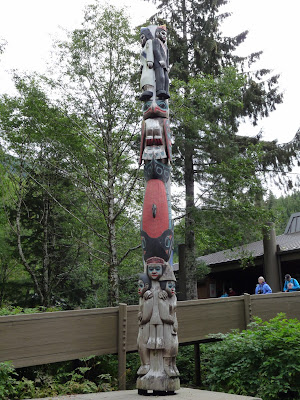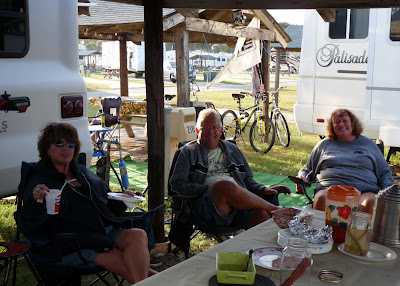Our ship didn't dock until 10AM at
Ketchikan so Denny and I had the opportunity to have a leisurely breakfast onboard and then we returned to our balcony to watch as we arrived in port.

Once the ship was secured, off we went to experience our
First City Deluxe Tour.

Boarding our bus we wound through town to the Deer Mountain Fish Hatchery where we learned about the life cycle of salmon from egg to their death after spawning.

When salmon start their swim back to their home area, they stop eating. By the time they arrive to start spawning, their bodies are depleting and they lose color, turning white. So by the time the spawning process is over, the salmon are mostly white. They are left to decompose where they die so that they enrich the soil and water and other creatures can feed upon them as part of the natural life cycle.

There is also a raptor educational center at the fish hatchery, where a handler gave a talk on this
peregrine falcon, a
turkey vulture and the injured eagles located there. The eagles had each lost a wing to collisions with electrical power wires.


A display of the various types of wild salmon.



Once everyone had finished asking questions about the salmon and the raptors we headed to the Totem Heritage Center.

The Totem Heritage Center was created to preserve early cedar
totems that had been left behind in abandoned Native camps and villages. Since totems are carved not only to tell local legends but also to describe personal family histories, an effort is being made to preserve and restore these works of art. As you enter the center you are greeted by a member of a local culture, such as the Tlingits, who speaks to you in his/her native tongue and then translates that to English. The native dialects are very musical to your ear. Once you go inside another native Alaskan will explain the history of totems and of the stories that the three totems highlighted at the entrance tell. Then you are allowed to wander through the building on your own to learn about the various totems inside.


All too soon we were herded into our tour bus for the short drive to Saxman Village, a native Tlingit village. Saxman Village claims the largest collection of totem poles from all over Alaska where work is ongoing to preserve them. There are thirty-four totem poles currently located here.



Denny and I also spoke briefly to a Native Alaskan who was currently working on carving a new totem pole, a process he learned from his uncle by way of apprenticeship. The totems are beautiful works of art as well as a storyboard of local lore.
The final part of our excursion was to the Discovery Center which housed displays about the native wildlife, geography and geology of the area. By this time Denny and I were full up to here with learning and left to wander Creek Street.

Creek Street, which is not really a street at all but a boardwalk over Ketchikan Creek, was originally the "red light" district of Ketchikan. Now the former brothels house restaurants, shops and museums such as that in the infamous "Dolly House". Prostitution was allowed in Ketchikan as long as the houses weren't on land and so the houses were built over the creek.



As we wandered the board walk we could see the salmon fighting their way up the creek to spawn, followed by a very hungry and thoroughly ecstatic harbor seal who was snapping a bite of salmon here, another chomp of salmon there as he worked his way upstream in the middle of town.
There are also many "streets" in Ketchikan that are simply long stairways to the various homes built on the hillsides in town. The longest of these is 2500 steps to the top. There is also a stairway know as the Married Men's Trail in town, which supposedly married men used to secretly walk to the bordellos on Creek Street. It begins at the fish ladder near the original fish hatchery in the middle of Ketchikan.
A visit to a couple of shops and jewelry stores in town and then Denny and I had to hustle back to the ship which left port early for the long trek to Vancouver. We would have one final day of sailing with no stops at port, simply scenic vistas and the opportunity to perhaps see some aquatic wildlife.
 I realize I've been MIA here at the blog this week. It's been a bit stormy at The Beast; not just the actual weather but our tempers have become a bit frayed after dealing with the folks at
I realize I've been MIA here at the blog this week. It's been a bit stormy at The Beast; not just the actual weather but our tempers have become a bit frayed after dealing with the folks at  * quote from Lewis Carroll's Through the Looking Glass.
* quote from Lewis Carroll's Through the Looking Glass.























































